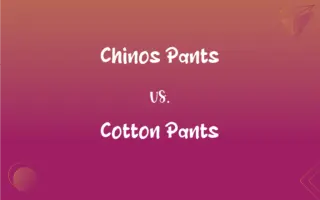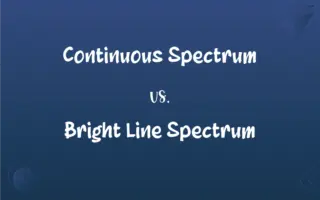Ethylene Glycol vs. Diethylene Glycol: What's the Difference?
Edited by Aimie Carlson || By Janet White || Published on September 5, 2024
Ethylene Glycol is a simple alcohol used in antifreeze, while Diethylene Glycol is a compound alcohol used in various industrial applications.

Key Differences
Ethylene Glycol (EG) is a colorless, odorless, sweet-tasting organic compound primarily used as an antifreeze and coolant in automotive engines. It is also utilized in the manufacture of polyester fibers and as a solvent in the paint and plastic industries. Diethylene Glycol (DEG) is a byproduct of Ethylene Glycol production and shares similar physical properties, such as being colorless and odorless. However, it is less volatile and has a higher boiling point than Ethylene Glycol, making it suitable for applications requiring higher boiling solvents.
The primary difference between the two compounds lies in their chemical structure and resulting physical properties. Ethylene Glycol has two alcohol groups attached to two carbon atoms, making it a simple glycol. Diethylene Glycol, on the other hand, is formed by the condensation of two Ethylene Glycol molecules, resulting in a compound with two ether groups in addition to two alcohol groups, giving it a slightly different set of properties such as higher viscosity and boiling point.
In terms of applications, while both are used as antifreeze, Ethylene Glycol is preferred in automotive applications due to its efficient heat transfer properties. Diethylene Glycol, with its higher boiling point and hygroscopic nature, finds more specialized industrial applications, such as in gas dehydration processes where its ability to absorb water is beneficial.
Safety is a significant concern with both compounds, as they are toxic when ingested. Ethylene Glycol poisoning is a medical emergency, as it can lead to metabolic acidosis, kidney failure, and central nervous system depression. Diethylene Glycol also poses health risks, particularly when mistakenly used in pharmaceuticals and food products, leading to several poisoning incidents historically.
Despite their toxic nature, both Ethylene Glycol and Diethylene Glycol continue to be widely used in various industrial and consumer products, with appropriate safety measures to prevent accidental ingestion and exposure.
ADVERTISEMENT
Comparison Chart
Chemical Structure
Two alcohol groups attached to two carbon atoms.
Condensation product of two Ethylene Glycol molecules with two ether and two alcohol groups.
Primary Use
Antifreeze in automotive engines, manufacture of polyester fibers.
Brake fluid, humectant in personal care products, higher boiling solvent applications.
Boiling Point
Lower compared to Diethylene Glycol.
Higher, making it suitable for high boiling point applications.
Toxicity
Toxic; can cause metabolic acidosis, kidney failure.
Also toxic; associated with poisoning incidents when ingested.
Physical Properties
Lower viscosity and boiling point.
Higher viscosity and hygroscopic nature.
ADVERTISEMENT
Ethylene Glycol and Diethylene Glycol Definitions
Ethylene Glycol
Toxic when ingested.
Ethylene Glycol poisoning can lead to serious health issues.
Diethylene Glycol
Less volatile with a higher boiling point than Ethylene Glycol.
Its stability makes Diethylene Glycol suitable for high-temperature applications.
Ethylene Glycol
Lowers the freezing point of water.
Adding Ethylene Glycol to water prevents freezing in car radiators.
Diethylene Glycol
Also toxic, associated with historical poisoning incidents.
Misuse in pharmaceuticals has led to Diethylene Glycol poisoning cases.
Ethylene Glycol
A colorless, odorless liquid used as antifreeze.
Ethylene Glycol is found in most automotive antifreeze formulations.
Diethylene Glycol
Used in brake fluids and wallpaper strippers.
Diethylene Glycol helps maintain the performance of hydraulic brake systems.
Ethylene Glycol
Acts as a solvent in paints and plastics.
Ethylene Glycol improves the properties of some paints.
Diethylene Glycol
Acts as a humectant in tobacco and cosmetics.
Diethylene Glycol helps keep products moist.
Ethylene Glycol
Used in the production of polyester fibers.
Polyester clothing is often made using Ethylene Glycol.
Diethylene Glycol
Higher molecular weight results in higher viscosity.
Diethylene Glycol's consistency is useful in certain industrial processes.
FAQs
What is Diethylene Glycol?
Diethylene Glycol is a compound alcohol used in industrial applications such as brake fluids, and as a humectant.
What is Ethylene Glycol?
Ethylene Glycol is a toxic organic compound used primarily as an antifreeze agent and in the manufacture of polyester.
How do Ethylene Glycol and Diethylene Glycol differ?
They differ in chemical structure, boiling point, and applications. Ethylene Glycol is used mainly as antifreeze, while Diethylene Glycol finds use in higher boiling point applications.
Are Ethylene Glycol and Diethylene Glycol toxic?
Yes, both are toxic when ingested and can cause serious health issues, including kidney failure and central nervous system depression.
What are the symptoms of Ethylene Glycol poisoning?
Symptoms include nausea, vomiting, central nervous system depression, metabolic acidosis, and kidney failure.
Has Diethylene Glycol been involved in any poisoning incidents?
Yes, there have been several incidents of poisoning due to the accidental or intentional adulteration of pharmaceuticals and consumable products with Diethylene Glycol.
Is there an antidote for Ethylene Glycol poisoning?
Yes, treatments include the use of antidotes such as fomepizole or ethanol, which inhibit the alcohol dehydrogenase enzyme from converting Ethylene Glycol to toxic metabolites.
What precautions should be taken when handling Ethylene Glycol or Diethylene Glycol?
Appropriate safety measures include using personal protective equipment, ensuring proper ventilation, and following handling and disposal guidelines to prevent ingestion and skin exposure.
Why is Ethylene Glycol used in the production of polyester?
Ethylene Glycol reacts with terephthalic acid to produce polyester fibers, which are used in textiles and plastics.
Can Diethylene Glycol be used as antifreeze like Ethylene Glycol?
While Diethylene Glycol can technically function as an antifreeze, Ethylene Glycol is more commonly used for this purpose due to its better heat transfer properties.
What makes Diethylene Glycol suitable for use in brake fluids?
Its higher boiling point and hygroscopic nature make it effective in maintaining the performance of hydraulic brake systems.
What environmental impacts do Ethylene Glycol and Diethylene Glycol have?
Both chemicals are toxic to aquatic life and can cause environmental harm if released into water bodies. Proper disposal and treatment of waste containing these chemicals are necessary to minimize environmental impact.
How can Ethylene Glycol and Diethylene Glycol poisoning be detected?
Poisoning can be detected through blood and urine tests that measure the levels of the substances or their metabolites, along with assessing symptoms and potential exposure history.
Are there any natural sources of Ethylene Glycol or Diethylene Glycol?
No, both Ethylene Glycol and Diethylene Glycol are synthetic chemicals and do not occur naturally. They are produced through industrial chemical processes.
What measures can be taken to reduce the risk of accidental poisoning with these substances?
Measures include using child-resistant packaging, storing chemicals out of reach of children and pets, and clearly labeling and educating about the risks of products containing Ethylene Glycol and Diethylene Glycol.
Can Ethylene Glycol and Diethylene Glycol be found in household products?
Yes, they can be found in various household products, including automotive antifreeze, hydraulic brake fluids, solvents, and some personal care products, emphasizing the need for careful use and storage.
Can Ethylene Glycol and Diethylene Glycol be used interchangeably in industrial applications?
While they share some properties, their use is not directly interchangeable due to differences in chemical structure, boiling points, and viscosity. Specific applications may require the unique properties of one over the other.
How are Ethylene Glycol and Diethylene Glycol produced?
Ethylene Glycol is produced from the hydration of ethylene oxide. Diethylene Glycol is a byproduct of this process, formed when Ethylene Glycol further reacts with ethylene oxide.
What is the role of Diethylene Glycol in the production of plastics?
Diethylene Glycol is used as a plasticizer in the production of some plastics, making them more flexible by reducing their viscosity and hardness.
How are spills of Ethylene Glycol and Diethylene Glycol managed?
Spills should be handled with caution, using personal protective equipment, and contained and cleaned up promptly to prevent environmental contamination and human exposure. Specialized disposal procedures must be followed according to local regulations.
About Author
Written by
Janet WhiteJanet White has been an esteemed writer and blogger for Difference Wiki. Holding a Master's degree in Science and Medical Journalism from the prestigious Boston University, she has consistently demonstrated her expertise and passion for her field. When she's not immersed in her work, Janet relishes her time exercising, delving into a good book, and cherishing moments with friends and family.
Edited by
Aimie CarlsonAimie Carlson, holding a master's degree in English literature, is a fervent English language enthusiast. She lends her writing talents to Difference Wiki, a prominent website that specializes in comparisons, offering readers insightful analyses that both captivate and inform.






































































